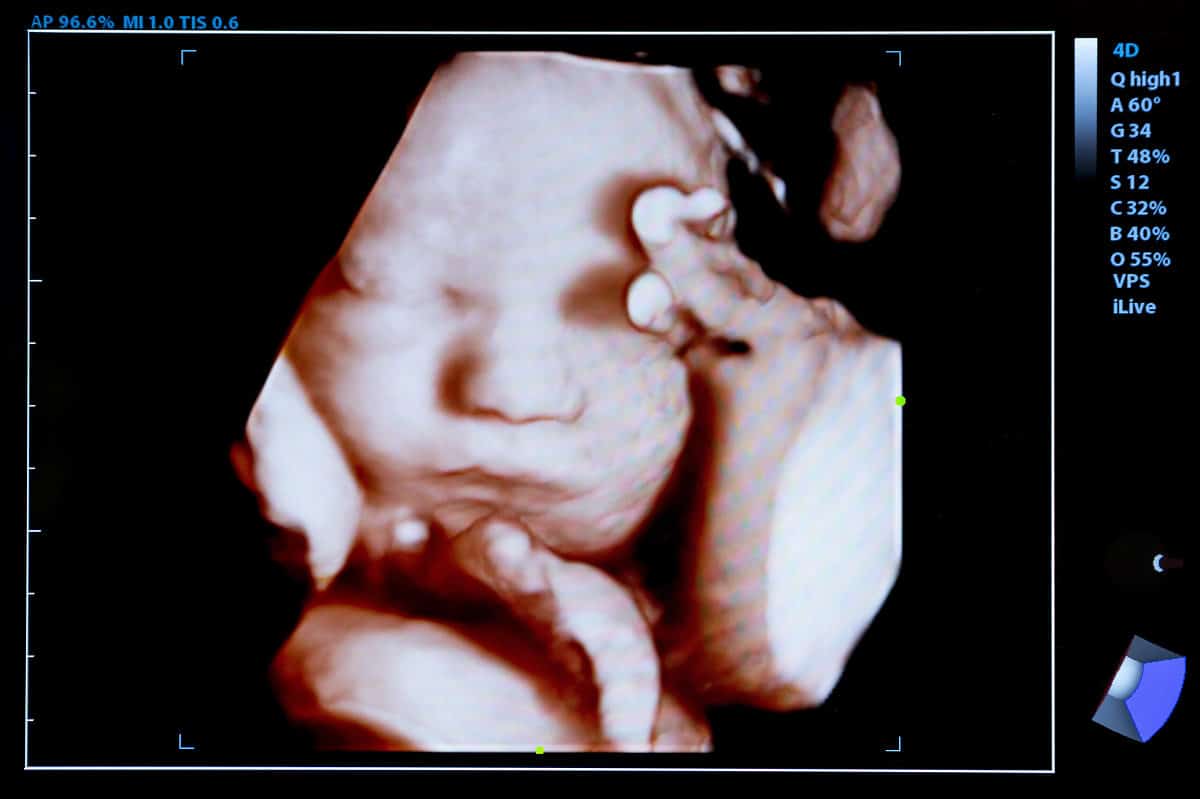The development of a baby inside of the womb is pretty incredible. For nine months, a woman’s body provides all nutrients necessary to help a baby grow, including providing oxygen. Since a mother’s womb is filled with amniotic fluid before birth, many wonder how babies can breathe in the womb.
Even though moms provide oxygen to their developing babies through the placenta, babies in the womb don’t breathe the way we do. Instead of inhaling air through their lungs, the oxygen they need is provided through the umbilical cord connected to the placenta. They don’t take their true first breath until after they’re born.
It’s fascinating how babies can receive everything they need through their mothers before birth. Keep reading to find out how babies breathe in the womb and during delivery.
Key Points of Babies Breathing in the Womb
- Babies in the womb receive oxygen through the umbilical cord, which is connected to the placenta.
- Fetal breathing movements begin around 11-12 weeks gestation, but these movements do not involve inhaling oxygen.
- During birth, while the baby is still attached to the placenta, they are still receiving oxygen through the mother's body until they can breathe on their own.
- Generally babies take their first breath within 10 seconds of exiting the birth canal.
How Do Babies Breathe in the Womb?
During pregnancy, a lot happens each week as babies prepare for life outside the womb and you prepare for life with your baby. Most moms wait nine months to hear the precious sound of their baby’s first breath, but you may wonder how babies breathe prior to birth while they’re surrounded by amniotic fluid.
Babies in the womb don’t breathe on their own the way we do. They’re receiving oxygen directly through the umbilical cord, which is connected to the placenta. Amazingly, the placenta is an organ that a woman’s body creates during pregnancy to nourish the baby. It even plays the role of several organs for the baby during development.
Babies in the womb can receive oxygen through the placenta since it takes oxygen molecules from the mom to give to the baby. When the baby sends out carbon dioxide, it’s passed back through the placenta for disposal.

©iStock.com/Cylonphoto
When Does a Baby Start Breathing in the Womb?
Once the placenta is developed, your baby starts receiving oxygen through the umbilical cord. This milestone typically happens around 12 weeks gestation although fetal breathing movements can be detected in the womb as early as 11 weeks. Even though the baby isn’t breathing in the traditional sense yet, these fetal breathing movements are practice breaths. Instead of breathing in oxygen, these breaths bring more amniotic fluid in and out of their lungs.
The practice breaths occur through muscle contractions and prepare your little one for life outside the womb. They can even be detected on an ultrasound. Even once a baby’s lungs are fully developed in the womb, usually around 28 weeks of pregnancy, the baby is still receiving oxygen through the placenta until after birth.
How Do Babies Breathe During Birth?
That first breath outside of the womb is what parents longingly wait for to ensure their baby is okay, but there are often many concerns about how the baby will breathe during the birth. As long as your baby is still attached to the placenta, they’re receiving oxygen from your body. They’re able to receive all the oxygen they need to sustain them, even during their trip through the birth canal, until they can breathe through their lungs.
Many pregnant women worry if the umbilical cord is wrapped around their baby’s neck it will keep their baby from breathing. However, having an umbilical cord wrapped around the neck is a common occurrence that happens to at least 37% of full-term babies. It isn’t associated with negative outcomes for the baby or mom although it can cause problems if it is tightly wrapped.
When Does a Baby Take its First Breath After Birth?
After birth, a baby will usually take their first real breath within ten seconds after they exit the birth canal. It often sounds like a gasp because their first breath is triggered by the change in environment and exposure to air. There’s nothing more relieving to a parent than a baby’s first breath.
The baby’s lungs quickly begin to drain the amniotic fluid after birth. The placenta is still providing nutrients as long as the baby is attached to it, even after their first real breath. This is why more parents are advocating for delayed cord clamping where cutting the cord is delayed by at least 25 seconds and up to five minutes. Studies have shown that delayed cord clamping leads to higher oxygen saturation and a lower heart rate.
Can a Baby Breathe During a Water Birth?
If you’ve ever considered a water birth, you might wonder how a baby can breathe during this type of birth. Since a baby’s first breath through its lungs is triggered by the change in environment, a water birth is meant to be a smooth transition from the womb to the world. Instead of immediately being exposed to a cold environment, the tub of warm water is a gentle transition.
For healthy babies, it’s unlikely that they would take their breath in the water before they were exposed to the air. However, moms who are having a water birth must keep their bottoms submerged in the water to avoid the baby being exposed to the air prematurely.
How Does Breathing Change after Birth?
When parents bring a new baby home, they tend to be preoccupied with their breathing. Every cough or grunt may cause alarm, especially for first-time parents. After your baby takes their first breath outside the womb, it takes some time to get used to breathing through their lungs.
You may hear frequent breathing sounds because newborn babies only breathe through their noses. This allows them to breathe and nurse at the same time. They often have a lot of mucus after birth as well, and some studies have shown that the length and type of labor can impact how much mucus a baby has. Typically, some of the amniotic fluid is squeezed out while the baby passes through the birth canal. However, in the case of rapid labor or c-section delivery, the baby has more fluid after birth.
Takeaway
A mother’s body can do incredible things, from growing an organ to supporting the life of a baby throughout pregnancy. During pregnancy, she provides everything her baby needs to survive, including a way to breathe in the womb. Even though babies in utero don't breathe through their lungs, they do take a lot of practice breaths to get ready for birth.
When your baby is born, there’s nothing quite like knowing your little one is finally here. No matter how you give birth, it’s important to know they are safe and breathing fine during the pregnancy.
The image featured at the top of this post is ©VK Studio/Shutterstock.com.
